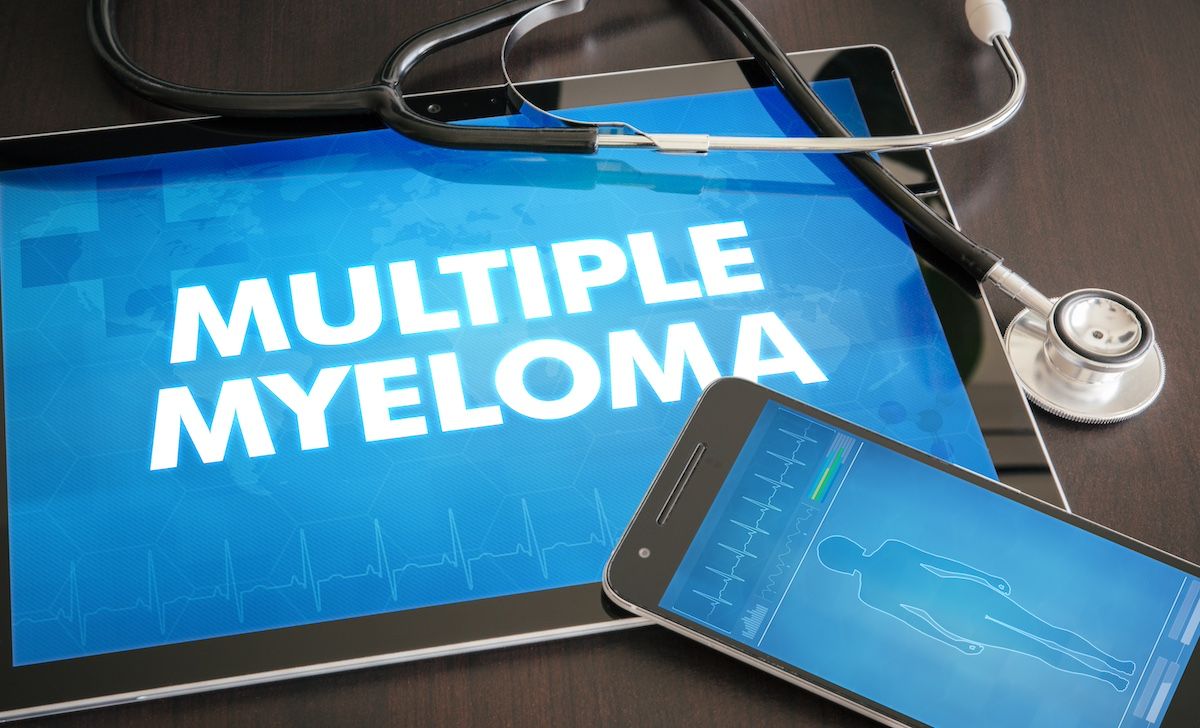Commentary
Article
Dr Matthew Lunning: Chaos of DLBCL Treatments Needs Organization
There are multiple treatment options becoming available for diffuse large B-cell lymphoma, but more work needs to be done to understand their efficacy and in what lines of therapy they should be used.
It remains to be seen how various therapies for diffuse large B-cell lymphoma will be used and in what order to treat patients, explained Matthew Lunning, DO, FACP, associate professor, Division of Hematology/Oncology, University of Nebraska Medical Center.
In an interview with The American Journal of Managed Care® (AJMC®) he reviewed bispecific antibodies versus chimeric antigen receptor T-cell therapy and the evolving understanding of when these agents should be used.
Lunning also discussed the challenges associated with using bispecifics and CAR T-cell therapy, adverse events, and more.
AJMC: How are patients sequenced for bispecifics versus CAR T-cell therapy in B-cell lymphomas?
Lunning: For the last 5 years, we've had CAR T-cell therapy approved for those patients with relapsed refractory diffuse large B-cell lymphoma. Initially, the approvals came in patients who had 2 prior lines of therapy or more. Most recently, the approvals of axicabtagene ciloleucel (axi-cel) and lisocabtagene maraleucel (liso-cel) in the second-line setting for those patients who have either primary refractory disease or disease that has relapsed within 1 year of completion of therapy has continued to open the door for CAR T-cell therapy. Most recently with the overall survival advantage coming from the ZUMA-7 trial1 with the utilization of axi-cell in that patient population, I really think it drives home and cements CAR T-cell therapy in that high-risk population, but also has continued to see uptake in patients in the third-line treatment setting and beyond.
Most recently bispecifics have entered into the market in relapsed-refractory diffuse large B-cell lymphoma, first with the subcutaneous injection epcoritamab, which is a CD3/CD20 bispecific, followed there shortly thereafter with glofitamab, another CD3/CD20 bispecific, but this time in an intravenous formulation. Both of these agents have impressive data in the relapsed refractory diffuse large B-cell lymphoma landscape. What I found equally impressive was their activity in that patient population that had previously had relapsed or refractory diffuse large B-cell lymphoma after receiving CAR T-cell therapy.
In my mind, with the recent ZUMA-7 results in that high-risk population and the longer term results in those patients in the third-line setting and beyond, if they have access to CAR T cell, I'm going to give CAR T cell first, followed by bispecifics in that patient population that either have refractory disease to CAR T cell or that have relapsed. Now there's going to be a subset of patients who don't have access to CAR T-cell therapy or can't get to CAR T-cell therapy fast enough. And I think that bispecifics are an option for that patient population.
What's going to live in the clinical trial realm is going to be: could bispecifics be used as a pre-apheresis bridging strategy and could they be used for or as a consolidative or maybe a maintenance approach to increase the efficacy of CAR T cells? While there's data for after CAR T cell in those patients who relapsed, we really don't have any data to say if a patient is in a partial remission at day 29 or a complete response at day 100, could we improve the median progression-free survival (PFS)? We know the median PFS really can be improved on, especially in the third-line setting and beyond, even in this high-risk population coming out of ZUMA-7 and TRANSFORM.2
I think while there are options that are approved right now for the relapsed-refractory diffuse large B-cell lymphoma patient—not only pre–CAR T and post–CAR T—I really think where we are going to see the advantages is bispecifics and CAR T trying to improve upon the outcomes of this population that still needs help even with the curative intent that CAR T-cell therapy affords.
AJMC: What are the specific challenges or limitations associated with the use of bispecific antibodies in B-cell lymphomas?
Lunning: I think that there are, first, the logistical challenges that any new drug that's coming to market has. I mean, these were 150 odd patient studies that led to their approval. So the broad utilization is very limited. In addition, you hear the toxicities of cytokine release syndrome (CRS) and immune effector cell-associated neurotoxicity syndrome (iCANS) that classically had come from cellular therapy that are now still present with these bispecifics. Challenges have been not only adoption of new therapies that didn't have broad clinical trial utilization across the United States, as well as the global community, and then the baggage that it carries with the adverse event (AE) profiling coming on the heels of cellular therapy or CAR T-cell therapy may slow it down.
Do I think that these will be, you know, something that won't be over- that cannot be overcome? No, I think they can be overcome. Because I think the efficacy of the drugs will make it necessary. These are drugs that will, I think, inherently be used first in academia and/or larger community practices that have experience with bispecifics on clinical trials. They will be the early adopters, and then you'll see adoption further on over time.
I think there will be some interesting insurance issues that will have to be sorted out. Like many therapies that have kind of early toxicity that then lessens over time, that are unique, it would be nice to have kind of created a system where the first couple of cycles—when the risks for CRS or iCANS are the highest, and potentially the assessment and monitoring are most essential—to be done in an area and in a center that's given these therapies before. And as that risk lessens, then the patient returns back out to their community closer to home.
I just don't know the insurance ramifications of that or for prior authorization for what are drugs in one center and then trying to transition to a different center with a potentially a different prior authorization. There may be health care settings where that transition could be easier, because there's more streamline between affiliates or partners, where you have your academic area and then the community partners that live in the same health care environment. But going from this academia to roll out into the community when there are separate entities with separate insurance processes, I think may be a little bit difficult or cumbersome at the infancy of these therapies.
So, undoubtedly, there's efficacy there, but I just see more logistical challenges, and being able to swallow the pill that there may be CRS and there may be iCANS and just the understanding of how to monitor for that. But the community got experience with checkpoint inhibitors, and now they infuse a lot of checkpoint inhibitors and understand the AE profile. So, I think with time, you know, that understanding will be there. It's just whether or not there'll be the patient population in need of seeing bispecifics early on to really necessitate early adoption.
AJMC: Let's discuss cytokine release syndrome. What are the best practices for monitoring and managing CRS associated with the use of bispecific antibodies?
Lunning: Inherently, I think assessing and monitoring for CRS and neurotoxicity is going to come out and be product specific. You know, what was done in the clinical trials shouldn't be forgotten, because there is a significant amount of insight that can be drawn from the individual clinical trials that led to the approval of each bispecific. Not only the route of administration, but the frequency administration, the pre-medication, the timing from infusion to first CRS event or neurotoxicity event should help and assist the providers that want to give these therapies.
For instance, right now, epcoritamab has steroids that are not only dosed with the product, but after the product for the first cycle. I think that was part of the risk mitigation for not only cycle 1, day 1, but day 8, and then at day 15 when the highest risk for CRS was seen in the clinical trials. That should not be forgotten, and nor do I think, without further clinical trial data, should be abandoned or should be shortened from that standpoint. It is a lot of steroids per se in that first month, but there's other regimens we see where steroids are part of the regimen. I mean, CHOP [cyclophosphamide, hydroxydaunorubicin, Oncovin, and prednisone] has 5 days of 100 milligrams of prednisone given every 3 weeks, and we do not freak out about giving that amount of steroids because it's impactful, likely, in helping with the AE of the drugs that are with it, but also it drives benefit. Who knows, you know, how these drugs behave without those premeds as well as those steroids? If you're going to reduce or taper off those steroids, you know, it should be done first in the setting of a clinical trial or in a more controlled setting.
With regards to glofitamab, it kind of comes back to the fact there is an obinutuzumab lead-in to that therapy. And again, just like steroids given after epcoritamab, one should not forget about the obinutuzumab lead-in. Again, not a lot of experience of knowing how glofitamab will behave from a CRS and a neurotoxicity standpoint without the obinutuzumab lead-in. I think it is incredibly important understanding that obinutuzumab lead-in and then with the first dose of glofitamab, that that's when the highest risk of CRS is with glofitamab. Not dosing that Obinutuzumab, who knows what the CRS risk or the grade of CRS risk is going to be with glofitamab. And so I think it is part of the regimen and should be discussed as part of the glofitamab-obinutuzumab regimen. Again, kind of also, but leading into steroid and premed utilization to help mitigate the CRS and the neurotoxicity with that agent.
AJMC: What operational opportunities exist to smooth the implementation and use of bispecific antibodies in B-cell lymphoma?
Lunning: I think right now it is sticking to the recipe. The clinical trial recipe with these new agents are important, and I think that that recipe relies upon the premedications that are given via the route that they're being delivered. Now, what happens to the treatment of CRS and neurotoxicity based upon the data, I think is also going to be an evolution. It really wasn't well spelled out in the clinical trials, and institutions kind of handled their CRS management. I think that that will continue to evolve. In my mind there's a difference of having CRS on a steroid and having CRS when they're not on a steroid. A person who is on epcoritamab who’s having CRS at day 2 after having received their prednisone, that is, in my mind, a different CRS event than if it's at day 4 and they're off the steroid. You may choose to do something differently or handle that CRS event differently.
How are we going to monitor these people? If it's a fever and they're otherwise feeling well, are we checking their blood pressures and pulse oximetry? Or are we assessing all individuals? I think that this will come with time. We understand the severity, where the majority of the CRS events are grade 1/2, or low grade, but we have to remember that with grade 2, patients require blood pressure–assisting treatment. As we've learned with infusion-related reactions with agents like rituximab, perhaps sometimes the therapy that's needed for people with hypertension is to hold their anti-hypertensive the day of the infusion, or the day after, or 72 hours after.
But again, these are the nuances that are going to come with more experience in the commercial environment of managing bispecifics. So I think we're still writing the management and how to best manage bispecifics outside of a clinical trial.
AJMC: What are you working on in the management of B-cell lymphoma that you are excited to share?
Lunning: Right now, there's a lot of chaos in relapsed/refractory diffuse large B-cell lymphoma, and chaos needs to be organized. Right now, I see this chaos as a chess board with multiple pieces and opportunities, and we're really setting up the table and reassigning the point values for the pieces, and the pieces are the drugs. Whether they're CAR T-cell therapies, bispecific antibodies, loncastuximab tesirine, polatuzumab, selinexor, tafasitamab, lenalidomide, each one of these are pieces on the chess board that are being reassigned point values based upon not only their efficacy, but also where their efficacy lies and what line of therapy. So, the board is always shifting, and the point value is changing.
Really the true research effort is how to find who can play on the chest board well together and who compliments each other. The true adversary across the board is large cell lymphoma. By using your rook and your bishop and taking out the queen to set you up to take out the king is incredibly important, and a lot of that's going to be done in the setting of clinical trials.
What I'm excited for is to see how bispecifics and cellular therapy can pin—to stick to the analogy—large cell lymphoma. And, I think, maybe those treatments being used in sequence may be helpful, but it doesn't mean that there can't be assists by other therapies. As polatuzumab moves into the frontline setting, we're going to need to find, in my mind, a replacement for some of that pre-apheresis bridging therapy—whether or not that's bispecifics, whether or not it's loncastuximab tesirine. We've been apprehensive to use CD19-perturbing agents in that pre-apheresis period, because it perturbs the CD19 antigen. But we've also been concerned about perturbing the T cells by using bispecifics, because we don't want to push towards an exhaustion phenotype.
But really, we have very little data. What I'm saying is more of a theoretical chess match rather than a chess match right now that I'm able to move pieces. When we get in this situation, it makes it very exciting to write clinical trials, to try to conduct clinical trials, and that's what keeps me up with the clock ticking in the chess game.
References
1. Westin JR, Oluwole OO, Kersten MJ, et al; for the ZUMA-7 Investigators and Kite Members. Survival with axicabtagene ciloleucel in large B-cell lymphoma. N Engl J Med. 2023;389(2):148-157. doi:10.1056/NEJMoa2301665
2. Kamdar M, Solomon SR, Arnason J, et al; TRANSFORM Investigators. Lisocabtagene maraleucel versus standard of care with salvage chemotherapy followed by autologous stem cell transplantation as second-line treatment in patients with relapsed or refractory large B-cell lymphoma (TRANSFORM): results from an interim analysis of an open-label, randomised, phase 3 trial. Lancet. 2022;399(10343):2294-2308. doi:10.1016/S0140-6736(22)00662-6
Newsletter
Stay ahead of policy, cost, and value—subscribe to AJMC for expert insights at the intersection of clinical care and health economics.




